NVIDIA Launches Shield Tablet
by Joshua Ho on July 22, 2014 9:00 AM EST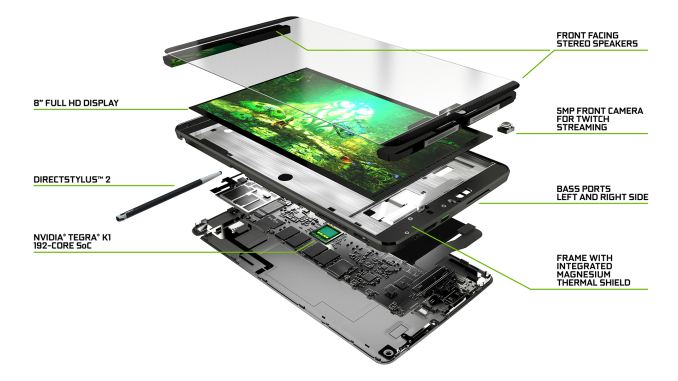
Today, NVIDIA is announcing the Shield tablet. While normally such launch announcements don’t require much in the way of exposition, NVIDIA is in an odd place. Last year, the Shield portable and Tegra Note 7 were the primary mobile devices shipping with Tegra 4. In hindsight, the Shield portable was a bit too niche to ever reach mass adoption. It was first and foremost a gaming device, with a display attached to a controller as opposed to a controller attached to a display. The result was that while it was surprisingly good for gaming, it wasn’t the best tablet. It really only worked in landscape mode, the display size was relatively small (5 inches diagonal), and using the touchscreen was an awkward experience.
The Tegra Note 7 was NVIDIA’s attempt at competing in the mainstream tablet market. While the dual front facing speakers and stylus were good advantages over the Nexus 7, it wasn’t clearly better than the Nexus 7. The display was lower resolution, lower contrast, and not as well calibrated. The WiFi module only supported 2.4 GHz, and there was only a gigabyte of RAM. While it was possible to emulate a Shield-esque experience with the Note 7, there was no game streaming from PC to tablet due to the lack of 5 GHz WiFi, and the controllers on the market simply weren’t as good as the controller in Shield. In addition, because the Tegra Note 7 wasn’t directly controlled by NVIDIA the experience in software update speed could vary.
From the lens of past experience, the Shield tablet makes a lot of sense. The specs are right for a good tablet, but it’s also a proper Shield device. As a tablet, it has all the right pieces. A high resolution display, Tegra K1 (Cortex A15 variant), dual front facing speakers and bass reflex ports, a new stylus, 5 GHz WiFi, and a 5MP front facing camera. I’ve put a table of the specs below for easier reading.
| NVIDIA SHIELD Tablet | |
| SoC | Tegra K1 (2.2 GHz 4x Cortex A15s) |
| RAM/NAND | 2 GB DDR3L-1866, 16/32GB NAND + microSD |
| Display | 8” 1920x1200 IPS LCD |
| Network | 2G / 3G / 4G LTE (NVIDIA Icera i500 UE Category 3/4 LTE) |
| Dimensions | 221 x 126 x 9.2mm, 390 grams |
| Camera | 5MP rear camera, 1.4 µm pixels, 1/4" CMOS size. 5MP FFC |
| Battery | 5197 mAh, 3.8V chemistry (19.75 Whr) |
| OS | Android 4.4.2 |
| Connectivity | 2x2 802.11a/b/g/n + BT 4.0, USB2.0, GPS/GLONASS, mini HDMI 1.4a |
| SIM Size | None or MicroSIM |
In the stylus side, DirectStylus 2 is said to reduce the inking latency to half that of the implementation we saw in Tegra Note 7. In practice it seemed that the stylus latency was low and lines tracked closely to the stylus, but I’ll avoid final judgment until the review. NVIDIA also claims that there are more levels of pressure sensitivity, but it’s not quite clear how many levels there are. NVIDIA has also added handwriting recognition software, which worked relatively well in some casual testing. The Dabbler application also seems to provide a relatively realistic simulation of various physical mediums such as oil painting and watercolor, although it’s mostly targeted towards artists.
In addition to the stylus features, NVIDIA is advertising 1080p Netflix support. Normally, due to the DRM restrictions associated with high bitrate streaming, most Android devices only support low resolution streams. NVIDIA has done all of the necessary work to satisfy these DRM requirements, so it supports the highest bitrate available to mobile devices. Of course, this feature will be disabled with an unlocked bootloader, but it’s a good feature to have for mobile streaming.
Outside of tablet features, the gaming features seem to be quite compelling. The controllers themselves were comfortable, and were very similar to the Shield portable’s ergonomics. NVIDIA is emphasizing that these controllers connect over WiFi direct, and the frequency selected depends upon the network that is used. The result is much lower latency, and NVIDIA is also able to run a headset jack and microphone through the controller due to the higher bandwidth that WiFi provides. Up to four controllers can be paired to the Shield tablet for multiplayer games.
Due to the addition of 5 GHz 2x2 WiFi, NVIDIA’s GameStream and GRID, which means that it’s possible to stream games from a PC within the same LAN to Shield tablet and play games by streaming from NVIDIA servers to the tablet. NVIDIA did note that only 720p is supported through WiFi, and an Ethernet connection is necessary to stream at 1080p due to latency reasons.
While both GameStream and GRID are largely similar in experience compared to the Shield portable, the Kepler GPU in the Tegra K1 enables a great deal of potential for gaming. Trine 2 will ship with the tablet, and is a direct port from the console game. NVIDIA also showed off the improvements in games like Half Life 2 and Portal, which run full OpenGL rather than OpenGL ES as it did on Shield portable. Outside of feature set, NVIDIA is claiming that the K1's GPU is far faster than the GPU in either the Exynos 5420 or Apple's A7 SoC.
In addition, NVIDIA showed off a full version of War Thunder running on Shield tablet, and claimed that it will be able to play on multiplayer with PCs. This included both the tank and aircraft combat aspects of the game. NVIDIA also showed that the Unreal Engine 4 demo from Google IO runs on the Shield tablet.
Finally, the Shield tablet will be the first Android tablet to support streaming to Twitch. By leveraging the built in front facing camera, it’s possible to stream both gameplay and webcam/commentary. In practice, I didn’t see any noticeable issues with this system, and it seemed to work as promised. The 1.4 micron pixel size seemed to make the quality relatively acceptable even indoors.
That was a lot to go over, but I think the key here will be the native gaming experience on Shield tablet. While it’s fully possible for Shield tablet to serve as a dedicated console with GameStream, the real use case will be whether it can provide a solid gaming experience using the SoC for rendering rather than as a video decoder for a PC somewhere else. With games like War Thunder and Trine 2, it seems that there is immense potential for a very compelling product. While NVIDIA isn’t starting from nothing this time around, this ecosystem aspect is still a bit risky.
The Shield tablet will go on sale July 29th for the US, August 14th for Europe. The 16GB/WiFi variant will cost 299 USD, the 32GB/LTE variant will be 399 USD. The controller is priced at 59 USD, and the flip cover at 39 USD.


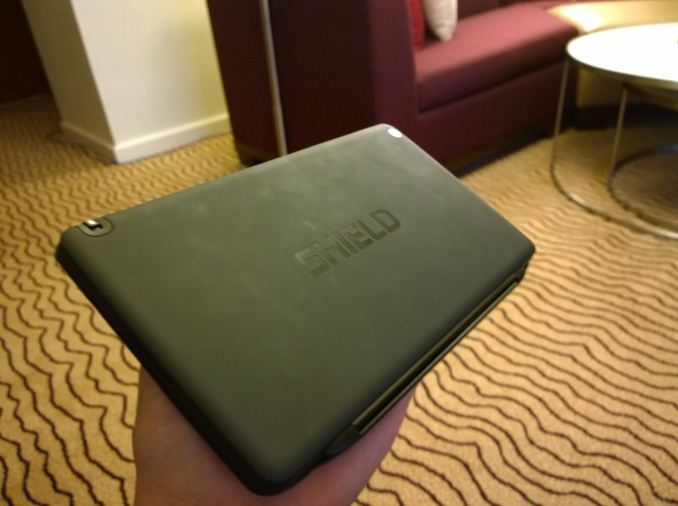
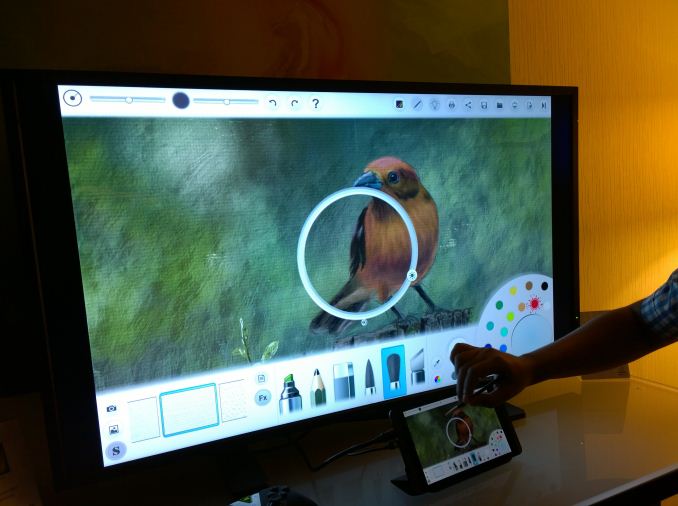
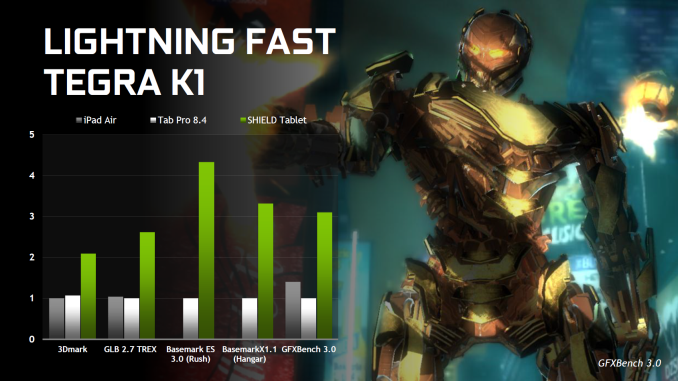

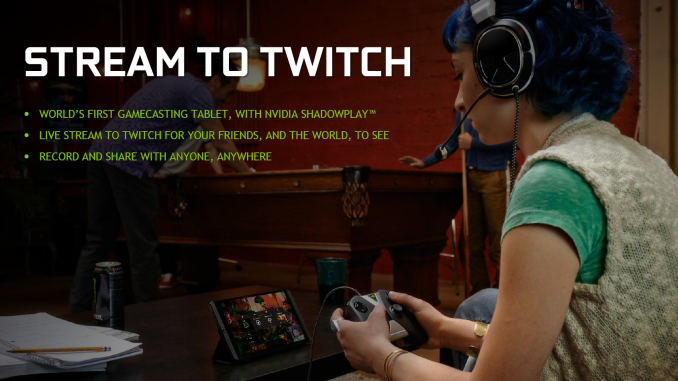








107 Comments
View All Comments
PEJUman - Tuesday, July 22, 2014 - link
I want whatever you're smoking. seems nice...chizow - Wednesday, July 23, 2014 - link
Yeah it's called reality, maybe you should stick it in your pipe and try it sometime.rampantarmadillo - Wednesday, July 23, 2014 - link
Reality is:#1 You're a shill. There's zero reason to bring Surface (Pro or otherwise) up in this comment thread.
#2 Microsoft's stranglehold on the industry is gone. They'll adapt or continue to lose market share. Regardless of your diatribe.
chizow - Wednesday, July 23, 2014 - link
Reality is, you're ignorant. I've been hugely critical of the Surface Pro 1/2 (just read the review comments), especially on pricing, and even more critical of the RT variants as being worst than Android/iOS for the SAME reasons they all fail compared to x86 Windows alternatives.I've also listed the very real use cases that have brought me to my conclusions. Why lug around a $300 tablet and $800 laptop when a $1000 device handles both use cases as good, or better? I think the market will continue to move in this direction, especially on the low-end where you can get cheap Atom-based alternatives with a full version of Windows (non-Pro) for the same price as Android options, and cheaper than iOS options.
The reality is, Android is still limited as a platform, sure this tablet differentiates itself with the gaming aspect, but as a pure gaming platform it has to contend with other options as well, like the next-gen consoles. Many others have come to the same conclusion if you bother to read the rest of the comments, I guess they are all console shills too huh?
rampantarmadillo - Wednesday, July 23, 2014 - link
"sure this tablet differentiates itself with the gaming aspect, but as a pure gaming platform it has to contend with other options as well, like the next-gen consoles. Many others have come to the same conclusion if you bother to read the rest of the comments, I guess they are all console shills too huh?"No. Their comments have relevance; this tablet aims at the gaming sector, so it's expected that folk would discuss the relative merits of consoles vs this device.
Your comments are obvious Microsoft propaganda.
Stock up on supplies, and dig in, because the future does not look good for you guys.
chizow - Wednesday, July 23, 2014 - link
Huh? And how are my comments any less relevant? If someone buys this, it will be solely for gaming because chances are they already have 2-3 Android/iOS devices that handle the non-gaming aspects just as good as this device ever will.If someone wants more than a gaming device, there are better options. Anyone buying this expecting more is going to be disappointed, as I have been for the last 3-4 years in the evolution of Android/iOS, so if you buy this, the gaming aspect needs to justify the $400 total price tag (with accessories) putting it into direct contention with the next-gen consoles. That's a much harder sell at that point.
My comments about Windows/Surface just re-emphasize the fact these toy OSes like Android/iOS are just that, toys that are probably best-suited for gaming, just don't expect it to be a full-featured platform like a Windows x86 based tablet that can do everything. No need to get all butthurt crying about propaganda, when in reality, its the truth.
rampantarmadillo - Wednesday, July 23, 2014 - link
I've posted a couple of tiny comments, focused on your lack of objectivity.. How am I "butthurt"?The market will decide (actually, lots of folk believe it already did).
chizow - Wednesday, July 23, 2014 - link
Lack of objectivity, lmao, from someone who can't even acknowledge the very obvious shortcomings of toy OSes like Android and iOS. I simply stated this tablet, like every other Android product before it, will never be as full-featured a solution as a Windows tablet for the reasons I've outlined in more detail when challenged on it.The market has begun to decide, based on the exact devices I was referring to:
http://www.zdnet.com/new-u-s-sales-figures-show-th...
http://www.maximumpc.com/asus_revenue_hit_record_h...
And ads like these hitting my inbox from major etailers further illustrating the shift in consumer/retailer focus:
https://email.microcentermedia.com/PS!tKqVQD4jKosF...
http://www.tigerdirect.com/email/retro/2014/WEBBP2...
Full-featured Win8.1 tablets for $150-$380, who in their right mind would pick an Android device over one of these at the same price points? Sure Shield Tablet has more of a gaming focus, but you better make sure you know what you are getting and why if you pull that trigger, or you'll just end up being disappointed.
rampantarmadillo - Thursday, July 24, 2014 - link
Links to competitor devices? Seriously?Shill.
chizow - Thursday, July 24, 2014 - link
lmao, keep burying head in sand, idiot. Yes competitor devices that further prove my point.